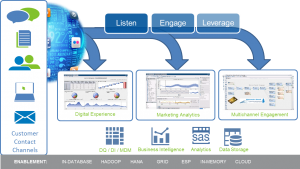Whether it’s to reduce churn in competitive markets or to elevate customer satisfaction rankings in regulated markets, customer analytics is hot right now in utilities.
However, the complexity that utilities have built into their processes and technologies over the past decades makes customer analytics a more challenging issue to tackle than one might think.
In addition, the utilities relationship with customers is impacted by broader consumerization evident across all markets. Consumers are more digital and connected than ever before. This is just one of three mega-trends that is impacting the landscape for utility marketers.

While utilities are not engaging through digital channels at the speed of retailers or banks, some utilities offer mobile payment options and most have some social media presence. To reach the empowered consumer, utilities will need to connect with the consumer at the point of making a decision that impacts their energy footprint, such as purchasing an electric car or solar panels. For utilities, this is a step along the journey to becoming a trusted energy advisor. To do so, utilities must leverage digital channels, including smart phones and social media, to provide valuable insights at consumer’s fingertips.
Secondly, all industries are facing an explosion of data. For utilities, that not only spews from grid asset sensors, but it also emanates from smart meters. That interval meter data can be analyzed to predict customer behaviors IF you can get the right data into the right hands at the right time. The relationship between CMO and CIO becomes paramount.
Last, marketing is both art and science. The brain of a marketer has to function analytically as well as creatively. There is a big demand for data scientists in the field of marketing analytics and utilities must to fight to recruit and retain this brainpower.
So how can the utility marketer be efficient in this complex social-centric data rich world?
Through thoughtful design and investment into proven technologies, utilities around the world have successfully implemented analytical marketing systems that complement existing CIS systems.

These systems capture big data and social data streams. This includes text from twitter and Facebook, or numeric data from smart meters, and other data that’s not really “big data” per se, like customer satisfaction surveys, and third party demographic data, and call center notes.
The utility of the future will need to understand customers individually, beyond the traditional household segmentation and rate categories. Just as not all utilities are regulated alike, not all customers behave the same in different geographies. Pricing or environmental factors may influence the adoption of various offers in one area more than others. Using sophisticated marketing analytics, utilities can automate a series of campaigns that targets those most likely to benefit from the energy program and most likely to respond.
With these strategies, powered by proven analytics, utilities will reach the new energy consumer and take another step in the journey towards the trusted energy advisor.
If you’re a member of Utility Analytics Institute, view a webinar about the utility analytics marketplace for more information. Or you can download this paper entitled: Analytic Strategies for the Customer-Centric Utility.
SAS has been delivering advanced analytics to utilities for over 38 years. All of the US utilities in the Fortune 500 are SAS customers and have been for an average of 30 years.
